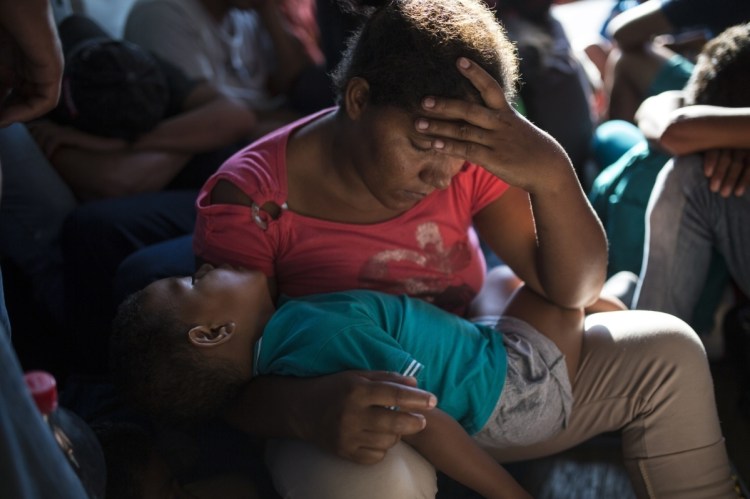ISLA, Mexico — Patience among 4,000 Central American migrants appeared to be wearing thin on Saturday, as exhausted members of the caravan journeying toward the United States openly disagreed with organizers who are shepherding the group through southern Mexico.
Several thousand migrants opted to rest in the towns of Juan Rodriguez Clara, Veracruz and Isla, Veracruz, which are about 40 miles from their previous rest stop in Sayula. Another contingent splintered off by hitchhiking rides and walking to Tierra Blanca, Veracruz, which lies about 80 extra miles to the north.
Many said they no longer had faith in those organizing the large group after confusion broke out regarding buses that would have taken migrants on a route to Mexico City.
COMMUNICATION BREAKDOWN
The tensions rose after Veracruz Gov. Miguel Angel Yunes reneged on a brief offer to provide transportation, saying that it would not be correct to send the migrants to Mexico City because the city’s water system was undergoing maintenance and 7 million of its people would be without water over the weekend.
In the lapse between his decisions, organizers told members of the caravan that buses would indeed be available, causing some migrants to go to sleep with the impression that they should wake up early to stake out a place in line.
Human rights activist Ernesto Castaneda said there’s still a possibility that bulk transportation will be arranged but as migrants struggle with exhaustion, blisters, sickness, and swollen feet hundreds of miles from the closest U.S. border, tempers flared within their ranks.
“People are mad and confused,” said Saira Cabrera, a 36-year-old traveling with her husband and two children.
Gerardo Perez, a 20-year-old migrant, said he was tired.
“They’re playing with our dignity. If you could have only seen the people’s happiness last night when they told us that we were going by bus and today we’re not,” he said.
BY ANY MEANS NECESSARY
It remained to be seen if the group would stick together and continue employing the “strength in numbers” strategy which has enabled them to mobilize through Mexico and inspire subsequent migrant caravans to try their luck.
On Friday, another caravan – this time from El Salvador – waded over the Suchiate River into Mexico, bringing 1,000 to 1,500 people who want to reach the U.S. border.
That caravan initially tried to cross the bridge between Guatemala and Mexico, but Mexican authorities told them they would have to show passports and visas
The Salvadorans opted instead to wade across a shallow stretch of the river.
Mexico is now faced with the unprecedented situation of having three caravans stretched out over 300 miles of highways in the states of Chiapas and Veracruz, with a total of more than 6,000 migrants.
The first, largest group of mainly Honduran migrants entered Mexico on Oct. 19. The caravan has shrunk to less than 4,000 migrants.
Another caravan, also of about 1,000 to 1,500 people, entered Mexico earlier this week and is now in Mapastepec, Chiapas. That group includes Hondurans, Salvadorans and some Guatemalans.
In addition, the government identified a smaller group of 300 Central American migrants, also in Veracruz, walking further ahead.
Mexican officials appeared conflicted over whether to help or hinder their journeys.
Immigration agents and police have at times detained migrants in the smaller caravans. There has also been pressure on the main caravan, with federal police pulling over freight trucks and forcing migrants off, saying that clinging to the tops or sides of the trucks was dangerous.
But several mayors have rolled out the welcome mat for migrants who reached their towns – arranging for food and camp sites. Mexico’s Interior Department says nearly 3,000 of the migrants in the first caravan have applied for refuge in Mexico and hundreds more have returned home.
With or without the government’s help, uncertainty awaits.
President Trump has ordered U.S. troops to the Mexican border in response to the caravans. More than 7,000 active duty troops have been told to deploy to Texas, Arizona and California.
Trump has also told the U.S. military mobilizing at the southwest border that if U.S. troops face rock-throwing migrants, they should react as though the rocks were rifles. He plans to sign an order next week that could lead to the large-scale detention of migrants crossing the southern border and bar anyone caught crossing illegally from claiming asylum.
Send questions/comments to the editors.



Success. Please wait for the page to reload. If the page does not reload within 5 seconds, please refresh the page.
Enter your email and password to access comments.
Hi, to comment on stories you must . This profile is in addition to your subscription and website login.
Already have a commenting profile? .
Invalid username/password.
Please check your email to confirm and complete your registration.
Only subscribers are eligible to post comments. Please subscribe or login first for digital access. Here’s why.
Use the form below to reset your password. When you've submitted your account email, we will send an email with a reset code.